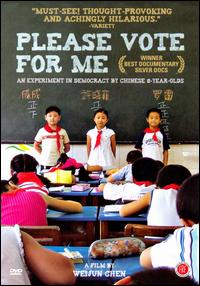Chinese tally marks
 I just finished watching the documentary “Please Vote For Me” by Chen Weijun as aired on the CBC. It is 45 minutes of the drama involved in an election at a public school in Wuhan where three students get to run for the position of class monitor and have the other students vote. One of the three students almost ruined it for me by being such a brat, and I fear for anyone among the 老百姓 who someday fall under his domain.
I just finished watching the documentary “Please Vote For Me” by Chen Weijun as aired on the CBC. It is 45 minutes of the drama involved in an election at a public school in Wuhan where three students get to run for the position of class monitor and have the other students vote. One of the three students almost ruined it for me by being such a brat, and I fear for anyone among the 老百姓 who someday fall under his domain.
One part of the film caught me a little by surprise. Near the end, as they were finally counting the votes, they employed a tallying system that I’d heard of once before, but it was so long ago and poorly explained that I mostly shut it out of my memory.
Rather than doing tallies as I learned, I.e. Four vertical strokes followed by a fifth diagonal/horizontal across the first four, the students in the film composed the character 正, one stroke at a time. 一,丅,下 etc. You can see it on the blackboard in the poster for the movie, though it’s kind of a spoiler.
I asked Syz about this the other day. He had this to say:
In general, I see lots of people use 正 for one, two, three, four
[PBS] says they use it a lot at [elementary] school in math class and other places, but she doesn’t recall using it much just herself among friends.
Too bad you didn’t ask me this question a couple of days ago. I went out with a bunch of people for Korean food (of all things) and I think I vaguely remember seeing on the tab that they were using tally marks. It would have been a great graphic for you.
Alas, we must make do with the poster. Personally I think I prefer the 正 method, since it’s harder to mess up. Not that the usual Western method is so difficult, but one could always try to fit in one more stroke in there to short count their opponent. I know, it’s a stretch.
I’m sure this system is widely known by every 10 year old in the Mandarin speaking world. Still, it was mostly new to me and I thought others might find it interesting. In fact, In four years of doing this China thing, this is actually the first time ive seen it used.
This is also frequently used in Taiwan when ordering dishes in a restaurant. Instead of using Arabic numerals, you use 正 to indicate the quantity you’d like.
This is widely used in Japan as well.
I’ve noticed that it’s not always composed as the character 正 — sometimes the two verticals will be hung from the top bar in succession, like ᅲ.
For the record, if I’d known I was going to be quoted, I’d have added a “five” onto “I see lots of people use 正 for one, two, three, four”
jdmartinsen: interesting one. That might’ve been what I saw at the Korean restaurant. I’ll have to collect some pics.
Aaron stole my comment.
Anyway yes, this is definitely a real thing in Japan and in Japanese restaurants in America run by Japanese people.
When I was teaching in Japan, I tried to get them to use the |||| method, but no one took it up.
Err, that should have been the
||||method.Sorry Syz.
@Kellen: hey, i’ll live
@Carl: nice use of crossout! I even thought about trying to find a font for that but…
I had the crossout but ditched it for aesthetics.
Sorry about typos. iPad.
when i was in beijing, one of the gulou area bars kept tabs this way. “keeping a tab open” meant that the owner tallied up the # of drinks you’ve had by writing 正, and then counting up everything at the end of the night to tell you how much you owed.
They use a system like that in some Korean restaurants – But for some reason I want to say they do it more upside down…
Yup, it’s pretty universal in China, Taiwan, Japan, Korea – and diasporic restaurants as Yi Chonsang says.
Surprisingly, as I googled for 正字计数, most sites cited the example of counting ballots! I hadn’t realized it was so closely associated with this activity. A baidu traces it back to the late Qing, early Republican period: http://baike.baidu.com/view/1261589.htm. And as I googled further, I found that wikipedia itself has a nice illustration of the stroke order in an article on Tally Marks: http://en.wikipedia.org/wiki/Tally_marks, see also http://zh.wikipedia.org/zh/計數符號
It’s used in Singapore too – I don’t know if I learned it in class, but I definitely saw Chinese friends (i.e. Singaporean Chinese), kids and adults, using it.
In France, I have more commonly seen a square made of four strokes and then filled by a final fifth stroke, instead of the
||||method